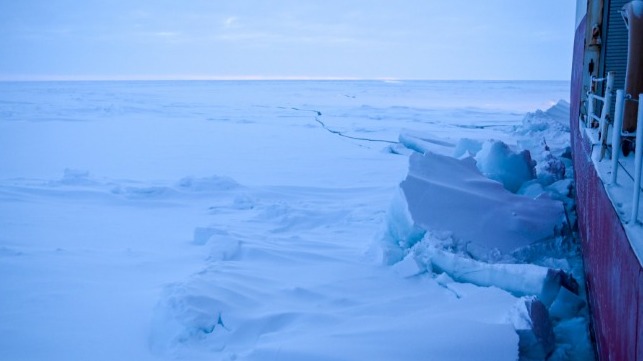A Break in the Silence: The Sound of a Winter Arctic Voyage

On a months-long winter mission to project U.S. sovereignty and to conduct scientific research, the Coast Guard cutter Polar Star, the nation’s sole heavy icebreaker, is using its one-of-a-kind capability to navigate the dark polar wilderness.
After departing Seattle, crossing the Gulf of Alaska and transiting the Bering Sea’s treacherous waters, where 20-foot swells mercilessly tossed the ship, the crew traversed the Arctic Circle into equally windy but far calmer ice-bound waters.
After a few dark days and nights of the Polar Star methodically backing and ramming northbound through the Chukchi Sea’s heavy blanket of sea ice, crewmembers started to chatter about something keeping them up at night.
The polar sailors, many who sleep in staterooms on a lower deck of the ship, were taking collective notice of a persistently clamorous sound.
Though the crew who serves aboard Polar Star are not strangers to ice-serenaded work and slumber, this Arctic patrol was audibly different than prior, more routine icebreaking deployments to the opposite end of the world.
Polar Star annually travels to world’s southernmost continent in support of Operation Deep Freeze where skilled ice pilots drive the powerful ship through ice up to 21 feet thick. The icebreaking mission opens critical navigation channels for other ships allowing for essential supplies to be delivered to scientists conducting research at McMurdo Station in Antarctica.
When, earlier in 2020, Operation Deep Freeze was cancelled due to COVID-19 safety concerns at the station, the Polar Star crew instead headed north on the Chukchi Sea – farther north than any U.S. surface ship ever travelled in the winter – in support of the Coast Guard’s Arctic Strategy.




Images courtesy USCG
Navigating one of the world’s most northern frozen oceans presented the Polar Star crew an auditory experience far different than its southern sister ice. No two crewmembers describe the omnipresent sound of patrolling the Chukchi Sea similarly and creative metaphors for labeling the noise quickly became an amusing way for the crew to make light of the often palpable noise.
Like screeches and bangs from a perpetual car crash, a blaring elephant, freight train, or driving through concrete, freshly broken Arctic sea ice, scraping alongside the Polar Star’s hull, holds the likeness of screaming. It was a mysterious conundrum leaving many of the crew wide-eyed and wondering “why is this Arctic ice so loud?”
Fortunately, the Polar Star deployed north with a handful of scientists and researchers to advise the command and collect Arctic data in an effort to lessen the void of information available from the region. Evan Neuwirth, an ice analyst from the U.S. National Ice Center in Washington, D.C., is aboard Polar Star and proposed a theory about why navigating through Arctic ice is so noisy.
Neuwirth said temperature may be the greatest factor contributing to the sound heard while icebreaking. Sea ice in the winter is generally more dense, cold and brittle than in the summer. When winter Arctic ice strikes or rubs alongside the Polar Star’s exterior, more of the impact energy is transferred to the hull which results in a louder noise. Ice the crew experiences on their southern summer patrols is warmer and softer, making it more likely to compress and crush on impact with Polar Star – resulting in the absorption of energy that would otherwise result in a lot of noise.
To best understand his theory, Neuwirth said to think of what it would sound like to throw a snowball at the ship’s hull versus a solid chunk of ice.
The winter Arctic air and ice is so cold, often well below zero with the wind temperature factored in, that even after being broken into pieces, the ice chunks remain rock-hard creating the notorious noise. The process has, for the most part, been accepted by the crew as part of their unique, historic polar experience.
By experiencing and operating in one of the world’s most remote and harsh environments, the Polar Star crew is gaining critical familiarity of the Arctic necessary to develop and train future polar sailors and advance U.S. interests and power in the region.
As the Polar Star’s understanding of the Arctic grows by the day, one thing the crew knows for sure is that patrolling the frozen winter world above the Arctic Circle is desolate, dark and serene, but from aboard the Coast Guard Polar Star – it’s far from silent.
Co-written by Petty Officer 1st Class Cynthia Oldham & Petty Officer 2nd Class Tedd Meinersmann. This article appears courtesy of U.S. Coast Guard News and may be found in its original form here.
The opinions expressed herein are the author's and not necessarily those of The Maritime Executive.
